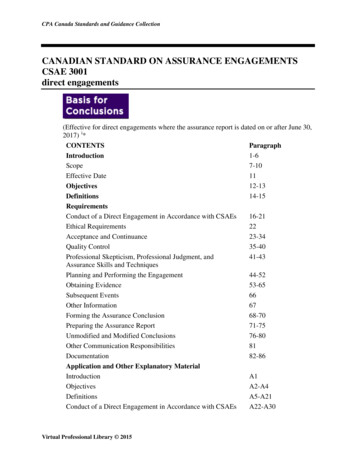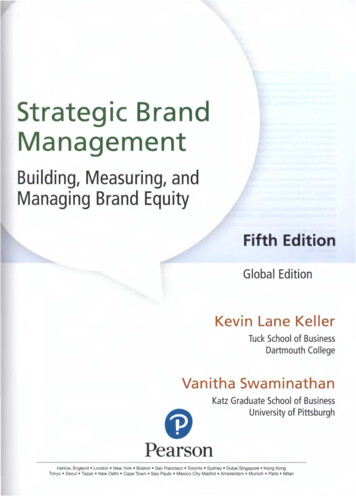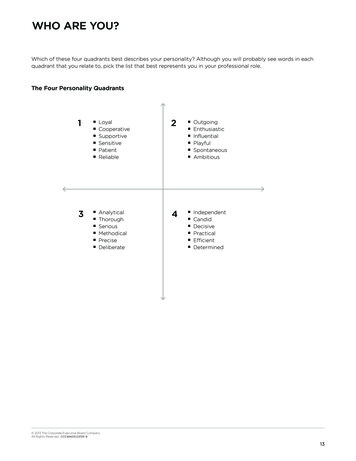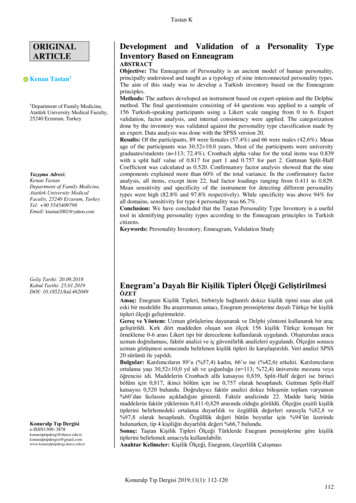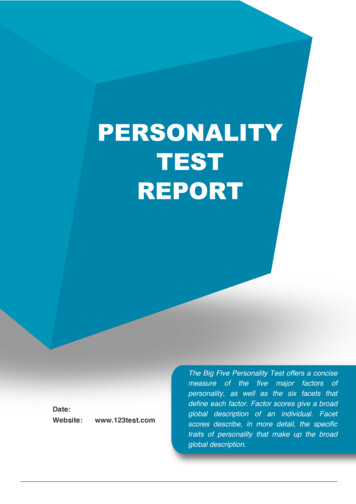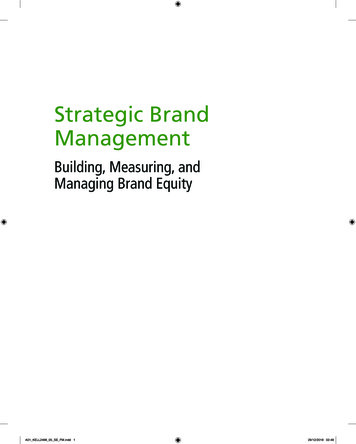
Transcription
Brand Personality and Brand EngagementRonald E. GoldsmithFlorida State UniversityElizabeth B. GoldsmithFlorida State UniversityMany brand theorists argue that a brand’s personality plays an important role in generating consumerengagement with the brand. Although anecdotal evidence and logical arguments support this assertion,researchers have published few empirical studies to verify it. The present study used data from a surveyof 132 U.S. college students to show that, indeed, personality dimensions perceived to be characteristic ofthe North Face brand of clothing do seem to increase engagement with this brand. The consumers viewedNorth Face as characterized by several positive dimensions, but the most crucial appeared to be that it isnot ordinary and that it is a responsible brand. These results not only support the claimed importance ofbrand personality, but also imply that North Face managers could stress these characteristics of theirbrand in their promotions to enhance its appeal to engaged and profitable consumers.INTRODUCTIONBranding is a crucial managerial task and consequently a major dimension of marketing theory andpractice. Two important aspects of branding are: (1) brands have personalities or human-likecharacteristics that distinguish them from each other, and these personalities are important to consumers;(2) consumers become "engaged" with brands, meaning that they feel special emotional and symbolicconnections with certain brands. Consequently, the topics of brand personality and the relationships thatconsumers form with their brands attract the attention of both managers (Birkner, 2011) and academicresearchers (Aaker, 1997) who share an interest in understanding why and how consumers formrelationships with brands (Grisaffe & Nguyen, 2011; Consumer Brand Relationship Colloquium, 2011).The nature of the brand personality/brand engagement relationship, however, has been little studied byresearchers.Two related concerns motivated the present study. The first is, if brands have personalities, how canthese be reliably and validly operationalized? Researchers have proposed self-report scales to measurebrand personality (e.g., Aaker, 1997), but none is universally accepted. Thus, we sought to determineempirically if a newly developed measure of brand personality (Geuens, Weijters, & DeWulf, 2009)could provide a unique profile of a brand with which some consumers are engaged. Second, managers andresearchers think of brand engagement not only as engagement with a specific brand but also a globalindividual difference variable that distinguishes the extent to which consumers tend to become engagedwith brands in general (Sprott, Czellar, & Spangenberg, 2009). We conceived the present study to testGeuens et al.'s (2009) brand personality scale by assessing its factor structure and relationship withAmerican Journal of Management vol. 12(1)11
engagement for a specific brand, i.e., North Face clothing. Our goals were to test the usefulness of thescale, verify empirically the personality/engagement link, and perhaps provide valuable insights to NorthFace managers. Our working hypothesis was that aspects of brand personality are associated with brandengagement, although we cannot predict precisely which aspects are because they should vary by brand.Measuring these associations gives valuable information to brand managers. We also sought to determinewhether Sprott et al.'s (2009) global brand engagement scale is related to engagement with this specificbrand. If so, this finding provides evidence for the validity of the global brand engagement scale andhelps empirically distinguish between these two related ways to conceptualize brand engagement. Failureto do so can lead to both managerial and theoretical confusion.LITERATURE REVIEWBrand Management and Consumer EngagementBranding is important for both companies and consumers, but for different, complementary reasons.Firms use brands because, according to Kotler (2000, p. 408), brands facilitate order processing andtracking, give legal protection to unique product features, make product extensions easy, and targetdifferent markets. Moreover, managers develop brands and brand strategies to accomplish five relatedgoals: (1) to distinguish their product from competitors and prevent it from being a commodity, (2) togive the product an image or personality, (3) to give the brand an identity, (4) to bolster the company'simage and reputation, and (5) to facilitate relationships with consumers that lead to long term value.When these goals are accomplished successfully and consumers see brands as similar to themselves(Malar et al., 2011) brands accumulate equity. Brand equity can be thought of as the marketing andfinancial value of a brand to the company arising from consumer awareness, their loyalty, qualityperceptions, and other associations (Aaker, 1991, p. 17; Ferrell & Hartline, 2005, p. 177). Equity in turnleads to long run profitability and consumer advocacy of the brand to others.Consumers contribute to the success of brand strategy and brand equity because brands are importantto them. First, consumers use brands to distinguish a company's offering from those of other companies;(2) this information allows them to make efficient judgments of quality, suitability, value and can promptquick purchase; (3) consumers use brands to create and display self-image and identity; (4) consumerscan interact with the brand and even co-create it; (5) consumers form relationships with the brand andconsequently the company that they find satisfying; (6) brand help consumers establish and maintainsocial relationships (see Haugtvedt, Herr, & Kardes, 2008; Maehle, Otnes, & Supphellen, 2011; Walker,2009). At the heart of the process by which managers create brand strategies and consumers participate inthem, yielding a brand identity, brand equity, long term relationships, and perhaps brand advocacy, is theinteraction of the brand's personality and the consumer's engagement with it (Goldsmith, 2011). Althoughhow consumers invest brands with human-like characteristics is understood (Maehle et al., 2011),empirical links between brand personality and consumer brand engagement are few. It is important toshow that the effort invested by managers and consumers into brand personality leads to the greater brandengagement that both parties desire.Brand PersonalityThe concept of brand personality features prominently in influential descriptions of brandmanagement and brand theory (e.g., Aaker, 1996; Keller, 2003; Haugtvedt et al., 2008). Brand personalityis argued to play an important role in brand positioning (van Rekom, Jacobs, & Verlegh, 2006) and toplay an essential role in brand attachment because consumers seek brands that reflect their self-images(Malar et al., 2011). Consequently, researchers have proposed self-report scales to measure brandpersonality as a set of aspects or dimensions (e.g., Aaker, 1996; Geuens et al., 2009). These scales differin terms of the number and choice of adjectives they use. Although the fifteen-item Aaker scale is themost prominent, Geuens et al. (2009) critique it for its loose definition of brand personality and the nongeneralizability and the non-replicability of its factor structure. In its place they propose a new,parsimonious brand personality measure consisting of 12 adjectives to operationalize personality12American Journal of Management vol. 12(1)
dimensions (see Table 1). A search by Google scholar yielded 13 citations to this paper, none of whichused it to assess relationships between brand personality and brand engagement, so the present study isone of the first studies of this topic. To verify the notion that brand personality is related to brandengagement and to partially validate the Geuens et al. (2009) scale, we propose the first hypothesis.H1: Aspects of the brand personality scale are related to engagement with a specificbrand (North Face), providing a profile of how the brand is viewed by engagedconsumers.Brand Engagement: Global and SpecificConsumers relate to brands in a variety of ways, and scholars use different terms for theserelationships, such as brand resonance, brand love, brand commitment, brand loyalty, and brandinvolvement (Consumer Brand Relationship Colloquium, 2011). Keller (2001) makes brand engagementa key component of his Customer-Based Brand Equity model. Building systematically from the basicconcept of brand salience, his model proposes that mangers can take specific steps to create brand equityby connecting with customers and making their brands relevant to their customers’ lives. The final goal isan intense, active relationship between the brand and the customer, part of which is engagement with thebrand expressed as customer eagerness to talk about the brand, learn about it, and exhibit its use(Goldsmith, 2011). The brand management literature is replete with recommendations and exhortationstelling managers to encourage their consumers to become engaged with specific brands (e.g., Sullivan,2009). Being engaged with a single brand, however, might also indicate a general to tendency to engagewith other brands. Sprott et al. (2009) describe this general tendency and propose a multi-item self-reportmeasure. We reason that being engaged with one brand is just one instance of this tendency, part of alarger pattern for some consumers. This link between single-brand engagement and global brandengagement has not been investigated, so we propose the second hypothesis, a positive (albeit weak)relationship between single- and global-brand engagement.H2: Engagement with a specific brand is positively related to brand engagement in selfconcept (global brand engagement).\METHODProcedure and ParticipantsWe collected the data using an online survey of college students enrolled in Human Sciences classesat a large southeastern U.S. university. Although this is a convenience sample with considerabledemographic homogeneity, the participants are members of the target segment for this brand, have goodexperience purchasing their own clothing, and represent both current and future customers for North Face.Walker (2009, p. 103) reports that teens, not far in age from our sample, have roughly 145 conversationsabout brands a week. Although the nature of the sample limits the generalizability of the point andinterval estimates, the focus was on theory testing and not providing a description of the target segment,and so constitutes a realistic source of data (Highhouse & Gillespie, 2009).The students were directed by email to an online survey site where they completed the questionnairefor extra class credit. Anonymity was guaranteed by not associated their identity with their responses. Thefocal brand was North Face clothing. We chose this brand after discussions with students determined thatit was widely recognized, suitable for both men and women, and reasonably priced so as not to be seen astoo cheap or too expensive to be a realistic clothing choice. The questionnaire contained an item askinghow familiar the participants were with North Face. The majority reported that it was either Very Familiar(27%) or Somewhat Familiar (52%), which only 13% reported that it was Somewhat Unfamiliar and only8% said it was Very Unfamiliar. Interestingly, we asked the participants to record their most favoritebrand, second most favorite, and third most favorite brand of clothing, and counted a total of 366responses. Not a single participant reported North Face among the many different brands mentioned. FreeAmerican Journal of Management vol. 12(1)13
People, Forever 21, and BCBG placed the most mentions across the three categories. Apparently, NorthFace is a well known brand with a unique personality, but not a favorite among this sample of consumers.The sample consisted of 126 women and 6 men, reflecting the demographics of the students in thiscollege. The effective sample size of 132 yielded at least 10 observations per independent variable in themain regression analysis and provided sufficient statistical power to detect a bivariate correlation of atleast .20 with p .05. The age of the participants ranged from 18 to 34, with a mean of 20.9 years (SD 2.3) and a median of 20 years.MeasuresWe designed the study to assess the relationship between brand personality and brand engagement.We used existing scales to operationalize the constructs (see Table 1). To test H1, the dependant variable,engagement with the North Face brand, was measured by a six-item scale described by Keller (2001). A7-point Likert response format was used where 1 Strongly Disagree and 7 Strongly Agree. Theprincipal independent variable, brand personality, was measured using the 13 adjectives proposed byGeuens et al. (2009) as a parsimonious, comprehensive measure. Survey participants evaluated NorthFace for each adjective using 7-point response format where 1 Not characteristic for the brand at all and7 Very characteristic for the brand. If the adjectives in Geuens et al. (2009) brand personality scale arenot related to engagement with a specific brand, it is hard to see how it validly operationalizes a concept(i.e., brand personality) in a way that is useful to either managers or researchers. To measure global-brandengagement and test H2, we used the Brand Engagement in Self-Concept (BESC) scale developed bySprott et al. (2009). BESC describes an individual difference variable that represents how muchconsumers use brands to form and project their images of self (Sprott et al., 2009). We were interested inhow engagement with a specific brand is related to engagement with brands in general.TABLE 1ITEMS USED TO OPERATIONALIZE THE -----------------------------------Brand Personality (Geuens et al., 2009)The North Face brand is:. . . down to earth. . . stable. . . responsible. . . active. . . dynamic. . . innovative. . . aggressive. . . bold. . . ordinary. . . simple. . . romantic. . . sentimentalNorth Face Engagement (Keller, 2001)1. I really like to talk about North Face with others.2. I am always interested in learning more about North Face.3. I would be interested in merchandise with this brand’s name on it.4. I am proud to have others know I use this brand.5. I like to visit the website for North Face.6. Compared to other people, I closely follow news about this brand.Brand Engagement with Self-Concept (Sprott et al., 2009)1. I have a special bond with the brands that I like.2. I often feel a personal connection between my brands and me.3. I feel as if I have a close personal connection with the brands I most prefer.4. I can identify with important brands in my life.5. There are links between the brands that I prefer and how I view myself.6. My favorite brands are an important indication of who I am.(Five-point Likert scale.)14American Journal of Management vol. 12(1)
Clothing Involvement (Mittal & Lee, 1989)1. I have a strong interest in clothing.2. Clothing is very important to me.3. For me, clothing does NOT matter.(Five-point Likert Scale)ShoppingI like to shop: 1 strongly disagree, 2 disagree, 3 neither, 4 agree, 5 strongly agreeI think shopping is: 1 very bad, 2 bad, 3 neither, 4 good, 5 very goodMy skills as a shopper are: 1 well below average, 2 below average, 3 average, 4 above average, 5 well above ---------------------------------In addition, we included in the survey two additional scales. The first, a three-item clothinginvolvement scale (Mittal & Lee, 1989), measures a potential influence on the primary relationshipsbetween brand personality and brand engagement. Our reasoning was that the more consumers wereinvolved with (excited by, interested in) clothing as a category, this influence might account for theirengagement with North Face. Finally, we created a three-item scale to measure a variable we call"attitude toward shopping" so that we could assess its relationship with North Face engagement so as toreinforce the notion that specific-brand engagement (and this scale operationalizes this concept validly) isimportant to managers. To describe shoppers involved with North Face as highly involved with clothingand as frequent shoppers gives managers important insights for developing strategies to reach theseconsumers by revealing broader characteristics that could guide media selection and advertising themes.If not related, this is valuable information as well.RESULTSPreliminary AnalysisThe first step in the data analysis was to purify the scales, evaluate their internal consistency, andassess discriminant validity. We used AMOS with maximum likelihood estimation to perform aconfirmatory factor analysis (CFA) of the four multi-item scales: North Face brand engagement, clothinginvolvement, BESC, and shopping attitude. This initial model did not fit the data well owing to highlycorrelated errors for two BESC items. We removed these two redundant items and repeated the analysis.The results showed a model that did not have an outstanding fit, but was adequate to permit furtheranalysis. This outcome was likely because of the relatively small sample size. The model fit statisticswere: χ2 on 129 df 233.7, p .0001, χ2/df 1.81, NFI .834, IFI .918, TLI .901, CFI .917,SRMR .077, and RMSEA .079. Item loadings ranged from .486 to .977 with all t-values greater than4.0.The Construct Reliability (CR), Average Variance Extracted (AVE), and coefficient alphacoefficients (see Table 2) indicated adequate internal consistency with the exception of the attitude towardshopping scale, which is not involved in the hypotheses tests and so should still be adequate to indicatethe managerial usefulness of the other findings. The correlations among the constructs appear in Table 2.The squared correlations are all smaller than their AVE’s, indicating good evidence for discriminantvalidity (Fornell & Larcker, 1981) as do the 95% confidence intervals around the construct correlations,which did not contain unity. Consequently, we summed the items for each construct to form compositescores (see Table 2).American Journal of Management vol. 12(1)15
TABLE 2DESCRIPTIVE STATISTICS OF NORTH FACE ENGAGEMENT, BESC, CLOTHINGINVOLVEMENT, AND SHOPPINGVariableMeanNorth )-.17**Note: CR Construct Reliability. Correlations in the lower triangle, AVEs on the diagonal, squaredcorrelations in the upper triangle. * p .05.In the absence of a more strenuous test for common method bias, we used the Harman One Factor test(Podsakoff et al., 2003) by running an exploratory factor analysis on all the individual eighteen indicatorsand examined the un-rotated factor solution. Four factors with eigenvalues greater than 1.0 were extractedand one factor did not account for the majority of the covariance among the measures, providing someevidence for the absence of common method variance in the data.Hypotheses TestsWe tested our first hypothesis, that aspects of brand personality are related to engagement with abrand, by correlating the North Face brand engagement scores with the 12 brand personality adjectiveratings (see Table 3). Eleven of these are statistically significant at p .01, although moderate in size.These results suggest that, as H1 hypothesized, differences in consumer perceptions of brand personalityare associated with engagement with it. The results show that these consumers feel that North Face has apersonality described as responsible, not ordinary, sentimental, romantic, active, dynamic, bold,aggressive, simple, stable, down to earth, and innovative. All these personality perceptions potentiallypromote engagement with the brand. Moreover, this information can inform promotional strategies forNorth Face.TABLE 3DESCRIPTIVE STATISTICS AND CORRELATIONS OF NORTH FACE PERSONALITYWITH NORTH FACE ENGAGEMENTVariable namicBoldDown to .001.916.054.203.715.243.485.415.424.29* p .05 ** p n Journal of Management vol. 2**-.10.33**.41**
To determine the multivariate association of the adjectives with North Face brand engagement, weregressed the latter across the 12 adjective ratings (see Table 4). The results show that only three of thepersonality dimensions, responsible, not-ordinary, and sentimental, have a statistically significant (p .05) association with brand engagement when all 12 adjectives are considered at the same time (R2 .46).Thus, these three aspects of brand personality dominate engagement with North Face. This finding is alsoapparent when examining the part (semipartial) correlations in the regression analysis (see Table 4),which report the "unique" contribution of an independent variable to explaining the variance in adependent variable. The squared semipartial correlation tells how much R2 will decrease if that variable isremoved from the regression equation. In this analysis, the adjectives responsible and ordinary accountfor the majority of R2, indicating their unique contribution to explaining variance in North Faceengagement. Scatter diagrams did not suggest any non-linear relationships between the adjectives andNorth Face engagement. A plot of the studentized residuals against the standardized predicted residualsshowed that the analysis did not violate the homoscedasticity assumption because this plot wassymmetrical about 0.0, indicating that the assumption was met; and no residual was larger than 3.0,indicating an absence of outliers.TABLE 4REGRESSION imentalRomanticActiveDynamicBoldDown to 1.041.00.777.677-.61.439-.05.001 70.068.052.046-.041.030-.003Note: R2 .457, Adj.R2 .402, df 119, F 8.33, p .001. a The part coefficient shows the unique effect of theindependent variable on the dependent variable.To test the second hypothesis, that Brand Engagement with Self-Concept is positively related toengagement with North Face, we correlated BESC with engagement with North Face. These results (seeTable 2) show that H2 is supported by the positive correlation (r .26) between BESC and North FaceEngagement. Both variables were negatively skewed, but data transformations did not change the resultsof the analysis. The modest size of the correlation, however, supports the notion that being engaged with aspecific brand is not that same as being engaged with brands in general as a means of forming andexpressing self-concept. The one concept should not be substituted for the other either in applied ortheoretical studies.Subsequent AnalysesT-tests comparing the mean familiarity scores of the 104 participant who were very or somewhatfamiliar with North Face with the 28 who were somewhat or very unfamiliar with it showed that theformer group reported a significantly higher level of North Face engagement (M 21.3, SD 8.1) thanthe latter (M 16.1, SD 6.8): t(130) 3.1, p .002, Cohen's d .55. The correlations in Table 2 of NorthFace engagement with clothing involvement and attitude toward shopping provide evidence for theAmerican Journal of Management vol. 12(1)17
importance of understanding specific brand engagement. These results help profile the engaged NorthFace buyer as one who is familiar with the brand, holds a specific image of the brand, but only mildlyinvolved with clothing as a category (r .18) and who likes to shop (r .30).Finally, we factor analyzed the 12 adjective ratings using principal axis factor analysis followed by anoblique rotation. This analysis produced a three factor solution in contrast to the five-factor solutionreported by Geuens et al. (2009). Our results showed that the adjectives ordinary and simple loaded on aunique factor labeled “simplicity” by Geuens et al., as did sentimental and romantic (labeled“emotionality”), but that the remaining adjectives formed one factor instead of the two labeled by Geuenset al. as "responsibility” and “activity,” and the adjective aggressive cross-loaded almost equally on boththese factors, positive on the responsibility/activity dynamic factor and negatively on the emotionalityfactor. It is possible that the small sample size used here compared with the large sample used by Geuenset al. could have accounted for our failure to replicate their structure exactly. Alternatively, thiscontradictory finding suggests that the structure of a brand's personality may vary from brand to brand sothat the search for a "stable" factor structure across brands is not likely to have a final answer.DISCUSSIONThe purpose of the present study was to assess empirically the association between brand personalityand brand engagement that so many branding researchers propose (e.g., Aaker, 1997; Geuens et al., 2009;Grisaffe & Nguyen, 2011; Maehle et al., 2011). To test this hypothesis we measured brand personalityand brand engagement for the North Face clothing brand. The results confirm that aspects of brandpersonality are related to brand engagement, confirming the hypothesis. We found that 11 of 12 adjectivescomprising the Geuens et al. (2009) brand personality scale were significantly associated with a measureof brand engagement for North Face. Of these, two in particular, responsible and not ordinary were themost important in differentiating levels of brand engagement. We feel these findings have importanttheoretical, managerial, and methodological implications.Theoretically, the results confirm the proposed association between brand personality and brandengagement that is felt to be an important explanation for how consumers become attached to specificbrands. The argument is that because in so many product categories brands are manufactured to haveequivalent quality standards and provide similar levels of utilitarian benefits, marketers must rely on theirbrand images to distinguish them from each other and to attract consumers to specific brands. Managingbrand personality is a principal way in which they do this (Grisaffe & Nguyen, 2011). Consumers seem toprefer brands with distinct personalities, probably because they can identify with the brand and use it toexpress their own personality (Maehle et al., 2011). By showing specifically which aspects of the NorthFace brand are associated with engagement, this study demonstrates this psychological linkage. Note,however, that we did not measure the individual self-images of our consumers and so must only assumethat those who are more engaged with North Face do so because they find similarities between itspersonality and their own personalities and values. Qualitative studies (Maehle et al., 2011) suggest thatthe human-like characteristics marketers imbue into their brands do lead to emotional bonds withconsumers. In the absence of an experimental study, however, we cannot definitely conclude that thedifferences in brand personality we assessed cause differences in brand engagement.Mangers should benefit from these findings in general because they demonstrate the usefulness of theBrand Personality Scale as a way to determine how consumers view their brand and use the findings topromote brands that play to the strengths of a brands personality. For example, in the case of North Face,promoting it through advertising, sponsorships, event marketing, and cause brand alliances in ways thathighlight the responsible and non-ordinary character of the brand should reinforce engagement with it.The results also suggest to North Face managers that their brand scores very high on the adjectives,active, stable, simple, and down to earth. This constellation of aspects gives a very distinctive and positiveplatform on which to build and extend the brand’s image. It is interesting to note that the two mostdeterminant aspects of the brand’s personality, responsible and not ordinary (Table 4), were not the most18American Journal of Management vol. 12(1)
highly rated characteristics of it (Table 3), suggesting that North Face might benefit from makingadditional efforts to associate these characteristics with the brand.Finally, from the methodological perspective, ours is one of the first studies to use the Geuens et al.(2009) scale. The findings clearly support its usefulness in assessing this brand’s personality, suggestingfurther use in both theory testing and managerially focused studies. Its ease of use and simplicityrecommend it, as does the coherence of its results. Thus, we accomplish the first goal of contributing tothe validity of this new scale. However, the failure to reproduce the same factor structure suggests furtherstudies are needed.The secondary purpose of the study was to investigate the relationship between a specific measure ofbrand engagement and a general measure in order to assess whether these two concept are distinctalthough scores on one scale should be correlated if only weakly with scores on the other. General brandengagement, in this case Brand Engagement in Self-Concept (Sprott et al., 2009) was related weakly toengagement with North Face, verifying the second hypothesis and the concepts' discriminant validity.Both measures of these concepts proved to have good psychometric characteristics and should proveuseful to future research.Our stu
brand expressed as customer eagerness to talk about the brand, learn about it, and exhibit its use (Goldsmith, 2011). The brand management literature is replete with recommendations and exhortations telling managers to encourage their consumers to be
